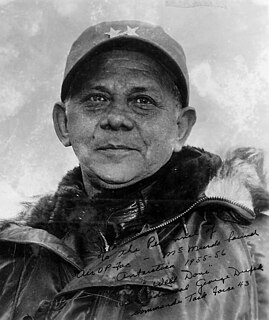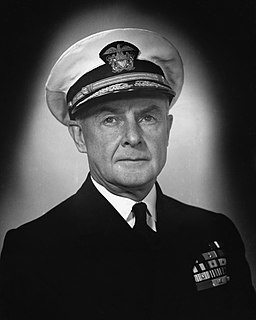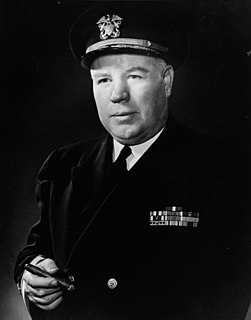Related Research Articles

USS Richard W. Suesens (DE-342) was a John C. Butler-class destroyer escort in service with the United States Navy from 1944 to 1947. She was finally sold for scrap in 1973.

USS Bennion (DD-662) was a Fletcher-class destroyer of the United States Navy. The ship was named for Captain Mervyn S. Bennion who was killed in action during the Japanese attack on Pearl Harbor, while in command of West Virginia. Captain Bennion was posthumously awarded the Medal of Honor.
USS Fowler (DE-222), a Buckley-class destroyer escort of the United States Navy, was named in honor of Lieutenant Robert L. Fowler (1919-1942), who was killed in action, while serving aboard the destroyer Duncan (DD-485) during the Battle of Cape Esperance on the night of 11–12 October 1942. He was posthumously awarded the Navy Cross.
Lloyd Thomas was an aviator in United States Navy who was killed in action in World War II during the Battle of Midway while attacking an Imperial Japanese Navy aircraft carrier.

USS Oberrender (DE-344) was a John C. Butler–class destroyer escort built for the United States Navy during World War II. She was named for Lieutenant Commander Thomas Olin Oberrender Jr., the engineering officer of the light cruiser USS Juneau, who was killed when that ship was torpedoed and sunk during the Naval Battle of Guadalcanal in 1942.

USS Holder (DE-401) was an Edsall-class destroyer escort built for the United States Navy during World War II. Named for Lieutenant Randolph Mitchell Holder, she was the first of two U.S. Naval vessels to bear the name.
Clark Franklin Rinehart was born in Ridgeway, Missouri, 30 May 1910.
Roy Orestus Hale Jr., born on 10 May 1916 in Monroe, Louisiana, graduated from the U.S. Naval Academy and was commissioned ensign in the United States Navy on 2 June 1938.
Severin Louis Rombach was an American naval aviator who was posthumously awarded the Navy Cross for service during World War II.
Max Silverstein was born in Chicago, Illinois, on February 15, 1911.

George John Dufek was an American naval officer, naval aviator, and polar expert. He served in World War II and the Korean War and in the 1940s and 1950s spent much of his career in the Antarctic, first with Admiral Byrd and later as supervisor of U.S. programs in the South Polar regions. Rear Admiral Dufek was the director of the Mariners' Museum in Newport News, Virginia after his retirement from the Navy in 1959.

Curtis William Howard was a United States Navy officer who received the Navy Cross posthumously for his actions during the Battle of Midway during World War II.
John J. Van Buren (1915–1942) was a United States Navy officer who received the Distinguished Flying Cross and Navy Cross for his actions in combat during World War II.

Paul J. Register was a United States Navy officer killed in action during the attack on Pearl Harbor for whom two U.S. Navy ships were named.

Stuart Howe Ingersoll was a vice admiral of the United States Navy. He was a naval aviator whose career included service as an aircraft carrier commander during World War II and tours as commander-in-chief of the United States Seventh Fleet, President of the Naval War College, and Commandant of Midshipmen at the United States Naval Academy.

Rear Admiral Herbert James Ray was an officer in the United States Navy who served in World War I and World War II. A 1914 graduate of the Naval Academy, he served on the submarines USS H-2 and N-3 during World War I. In March 1942, as Chief of Staff and Aide to the Commandant of the Sixteenth Naval District, Rear Admiral Francis W. Rockwell, he participated in General Douglas MacArthur's escape from the Philippines. In Australia, he served with MacArthur's General Headquarters, Southwest Pacific Area staff. In September 1943, he became Captain of the battleship USS Maryland, which he commanded in the Battle of Tarawa, Battle of Kwajalein, Battle of Saipan and the Battle of Peleliu. In October 1944, he participated in the Battle of Surigao Strait, in which Maryland joined the other battleships in engaging the Japanese battleships Fusō and Yamashiro and their escorts. Ray left Maryland in December 1944, and was promoted to Commodore and appointed Deputy Director of the Naval Division of the US Control Group Council for Germany. After VE Day, he became the Junior United States Member of the Tripartite Naval Commission in Berlin. He retired from the Navy on 30 June 1949, and received a tombstone promotion to rear admiral due to his combat decorations.

Vice Admiral Frank Jacob Lowry was an officer in the United States Navy who served in World War I and World War II. A 1911 graduate of the United States Naval Academy, he served on submarines during World War I. During World War II, he commanded the cruiser USS Minneapolis at the Battle of the Coral Sea, for which he was awarded the Navy Cross, and the Battle of Midway. He commanded the VIII Amphibious Force in the landings at Anzio and Southern France. He retired from the Navy in March 1950, and received a tombstone promotion to vice admiral due to his combat decorations.

Attack Squadron 35 (VA-35) was an aviation unit of the United States Navy. The squadron's nickname is unknown. Its insignia, a winged dragon, was revised several times during its lifetime. The squadron was first established as Torpedo and Bombing Squadron 2 (VT-2) on 6 July 1925, and was redesignated as VT-2B on 1 July 1927, VT-3 on 1 July 1937, VA-4A on 15 November 1946, and, finally, VA-35 on 7 August 1948. The squadron was disestablished on 7 November 1949. It was the first squadron to carry the VA-35 designation, the second VA-35 was redesignated from VA-34 on 15 February 1950 and disestablished on 31 January 1995.

Robert Graham Bradley was a United States Navy Lieutenant during World War II. He was posthumously awarded the Navy Cross for actions during the Battle of Leyte Gulf on USS Princeton (CVL-23). He was the namesake of USS Robert G. Bradley (FFG-49).

Vice Admiral Edmund Battelle Taylor was an admiral in the United States Navy. During World War II he saw service in the fighting in the Pacific, including the Battle of Cape Esperance, in which his ship, the USS Duncan was sunk, the Battle of Empress Augusta Bay and the Battle of the Philippine Sea. In the last months of the war he was the naval aide to the Secretary of the Navy, James Forrestal. After the war he commanded the Guantanamo Bay Naval Base and was commander of the Antisubmarine Defense Force, Atlantic Fleet, during the Cuban Missile Crisis.
References
- This article incorporates text from the public domain Dictionary of American Naval Fighting Ships .